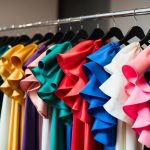
Occasion-Based Styling with Vintage
Incorporating vintage pieces into modern outfits can add character and uniqueness, whether dressing for everyday casual wear, a professional setting, or a formal event.
Casual and Everyday Wear
For casual looks, vintage pieces can give a contemporary wardrobe a fresh twist. A vintage band t-shirt paired with high-waisted jeans creates a laid-back yet stylish vibe. 60s-inspired floral dresses can also be a fun, lighthearted choice for daytime outings.
Accessories such as retro sunglasses or a classic leather belt can add subtle vintage touches without overwhelming the outfit. Mixing modern items like sneakers with vintage tops or bottoms balances the look, making it both comfortable and fashionable.
Professional and Business Looks
Vintage clothing can be leveraged to make professional attire stand out. A well-tailored vintage blazer from the 80s can turn a standard pantsuit into a conversation piece. Pencil skirts from the 50s paired with modern blouses create an elegant, polished look suitable for any office.
Choosing subtle patterns and neutral colors keeps the ensemble sophisticated and appropriate for business settings. Shoes like vintage loafers or pumps can seamlessly blend the old with the new, presenting a perfect professional appearance.
Evening and Formal Attire
For evening and formal events, vintage pieces offer timeless elegance. A 1920s beaded flapper dress or a 1950s tea-length gown can make a dramatic statement at a cocktail party or black-tie event. These items often feature intricate details and craftsmanship not always found in modern apparel.
To keep the look current, integrate contemporary accessories such as minimalist jewelry or sleek modern heels. This mix of eras creates a balanced, sophisticated outfit suitable for any formal occasion, ensuring a stylish and unique appearance.
Sustainable Fashion: The Role of Vintage
Vintage fashion plays a significant role in sustainable fashion by reducing waste and promoting recycling. Modern fashion typically follows a cycle where clothes are quickly discarded. Vintage pieces, however, extend the lifespan of garments.
By choosing vintage items, consumers reduce demand for new clothing production. This decrease in production helps lower the environmental impact associated with manufacturing processes.
Vintage shops often carry high-quality items made from durable materials. These pieces showcase exceptional craftsmanship and timeless design. Investing in such garments can result in a more sustainable wardrobe that can be worn for years to come.
Additionally, vintage clothing encourages creativity. Mixing vintage with modern pieces enables unique, personalized styles. This combination reduces the likelihood of contributing to fast fashion trends, which are often detrimental to the environment.
The rise of vintage fashion has also spurred second-hand markets. These markets promote the circulation of preloved items, ensuring that clothes remain in use longer and reducing textile waste.
Choosing vintage is not just about aesthetics. It is a conscious decision that supports a greener, more sustainable future. Purchasing vintage also often supports local businesses and communities, rather than large-scale, environmentally damaging corporations.
Supporting sustainable fashion through vintage can be an accessible and stylish way to make positive environmental choices in one’s wardrobe.



